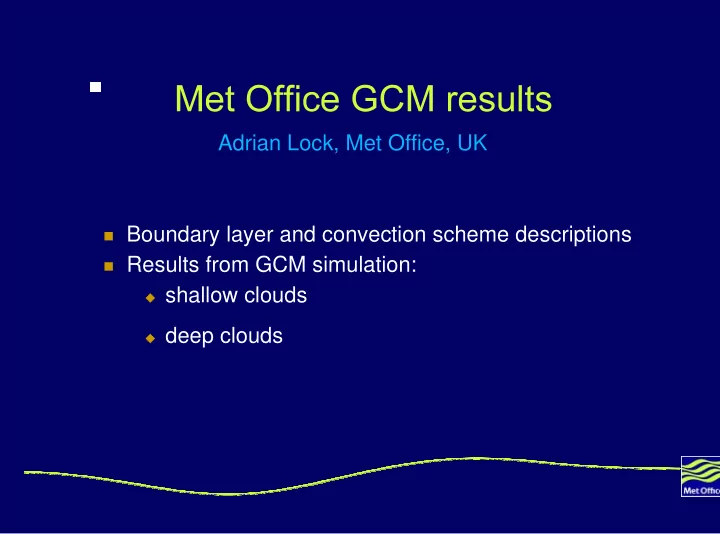

Adrian Lock, Met Office, UK � Boundary layer and convection scheme descriptions � Results from GCM simulation: � shallow clouds � deep clouds
Unstable boundary layer scheme Lock(2001) � 1 st order specified K-profile closure (HB 1993) � Mix conserved variables � l and q t � Additional K profile for cloud-top driven turbulence � Explicit diagnosis of c umulus based on comparison of q t gradients in cloud and subcloud layer. If cumulus: � Cap K profile at LCL � Trigger massflux scheme from LCL
Boundary layer scheme (continued) � Explicit entrainment parametrization (Lock, 1998) � Diagnose vertical extent of K-profiles by imposing a limit on the buoyancy consumption of TKE, using a subgrid diagnosis of cloud-base height: z z i i w b ' ' 0 dz D w b ' ' 0 dz � � � � � � � � � � � � � 0 0 With D=0.1 taken from LES
� Gregory and Rowntree (1990) mass-flux scheme (with RH-dependent CAPE closure for deep convection) plus: � Trigger at the LCL using cumulus diagnosis � Shallow convection parametrized with: � Grant and Brown (1999) entrainment/detrainment rates � m LCL = 0.03 w * � parcel just saturated with w � v LCL = - 0.2 w � v S
� ‘Climate’ model simulation � AMIP-style, prescribed SST � Resolution 2.5 0 latitude by 3.75 0 longitude (~300km in tropics) � 38 levels (~250m at 1km)
Californian stratocumulus – 1998 JJA mean Total cloud fraction Boundary layer top (m) Section 2
Cloud fractions, section 2 – 1998 JJA mean Layer cloud fraction Convective cloud fraction California
C Met Office a li f o r n Met Office i a � Cloud cover too high where Sc overlies Cu � LWP too low close to coast
SW forcing climatology: 5 year JJA mean (Met O - ERBE) � Negative implies ‘too much’ cloud so: � Do need less cloud towards trade Cu regions � No more cloud ‘needed’ close to coast
Diurnal cycle of LWP at 137W,27N 0630 local FIRE Met O 1530 local � Time lag in LWP relative to solar cycle well represented away from coast � But FIRE observations were at San Nicolas Island!
Stratocumulus cloud top height time series 800mb Met Office model subgrid inversion height Height (m) 1000mb
Met Office � The Met Office surface heat flux increases towards the coast, as the SST decreases. Is that because of its cloud-top entrainment rate? Entrainment warming � Balance between radiative cooling and entrainment Radiative warming leaves a ‘residual’ cooling surface heating Surface warming
Doubled – standard entrainment : July 1998 mean Total cloud cover Surface heat flux � So, a more active entrainment parametrization gives an equilibrium state with smaller surface heat fluxes and less cloud (Stevens 2002)
� The Met Office GCM produces a reasonably realistic stratocumulus sheet over the NE Pacific: � Good cloud cover and LWP diurnal cycle � Close to coast LWP is too small and diurnal cycle does not lag the solar cycle � Lack of resolution? � Horizontal: noise from the coastline � Vertical: cloud-top at 500m gives ~4 levels in the boundary layer so decoupling is hard
� Stratocumulus is too reflective, particularly when over shallow cumulus � Possible problem with Sc/Cu interaction (also with Cu/inversion interaction in general) � Radiative impact of cloud inhomogeneity? � The entrainment parametrization is behaving as predicted by Stevens (2002) – good or bad?
� It rains in the ITCZ - sometimes too much: Precipitation rate (mm/day) – June mean submitted results Met Office
� Much improved by recent change to diagnosis of when convection is shallow (require w 750hPa < 0) Precipitation rate (mm/day) – June mean Impact of change to shallow Cu diagnosis shallow if w 750hPa <0
� Extend the K-profile scheme, now operational for convective momentum transport, to the thermodynamic variables (shallow and deep) � Explore the interaction between cumulus, inversions and stratocumulus in LES (and thence improve its parametrization!)
Recommend
More recommend